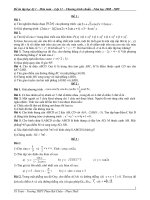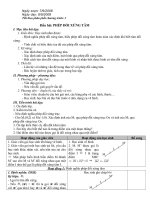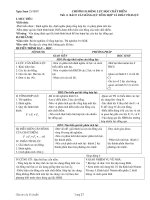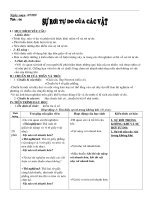Unit3 CB
Bạn đang xem bản rút gọn của tài liệu. Xem và tải ngay bản đầy đủ của tài liệu tại đây (126.65 KB, 10 trang )
Date of preparation: …………………
Date of teaching: …………………….
N
o
: 13
UNIT 3 : WAYS OF SOCIALIZING
A. Reading
I. Objectives:
1. Aims:
Ss read a passage about ways of socializing to understand some new words and phrases in the passage and the
content of the passage by doing the tasks.
2. Lexical items: Words and phrases relate to ways of socializing ( non verbal forms of communication )
II. Teaching aids: Tieng Anh 12, Teacher’s book, pictures, other aids
III. Procedure
1.Organization:
- What’s the date today ?
-Who’s absent today ?
Class:
……………………………………………………………………………. ………..
……………………………………..………………................................…………
2. Check up: T checks Ss’ exercise note books
3. New lesson:
Teacher’s activities Students’ activities
* Warmer:
T gives Ss some pictures
Picture 1: people clapping hands
Picture 2: waving hands
Picture 3: raising hands
Picture 4: nodding
Picture 5: pointing at people
T: What are the people in the pictures doing ?
Why do they do that ?
What do they do it for ?
T ( clap the hands ): Now the whole class, why do I clap the hands ?
Ss : To get our attention ( …)
T introduces and lead into new lesson: Ways of attracting someone’s
attention…
I. Before you read:
T asks Ss to answer the question 2 in the book
T goes round to check
T calls some Ss to answer
T introduces Ss :
verbal and non verbal communication.
get/ attract someone’s attention
nod (v) / wave (v)
II. While you read:
T introduces the passage and ask Ss to read and do task1 in the book.
1.Task 1:
T asks Ss to read the passage to guess the meaning of the words and
phrases given and give Vietnamese equivalent meaning of them.
T asks Ss to work individually, then in pairs to compare the answer
T checks and give the answers
Look at the pictures and
answer the T’s questions
Work in pairs to answer the
questions
Listen and take notes
Read the passage to guess the
meaning of the words and
phrases
2. Task 2: Answer the questions
T asks Ss to read all the questions to find out difficulties and T explains.
T asks Ss to work individually, then in pairs to compare the answer
T checks Ss’ answers
1. We can speak to that person or use non verbal or non verbal form of
communication.
2. They are strong actions ( jump up and down and wave as hard as you
can ) that can easily be seen .
3. We can wait until he passes near us , catch his eye and nod slightly to
let him know we would like him to come to our table, or we can raise
our hands slightly to show that we need assistance.
4. If you are walking across the schoolyard and see your teacher
approaching you , you can use a small friendly wave to attract his or her
attention.
5. Because pointing at someone is usually considered rude.
3. Task 3:
T asks Ss to work individually to choose the best tittle for the passage.
T asks Ss to work in groups of three to come pare the answer
T checks
A. ( Attracting attention: Non verbal cures)
III. After you read.
T asks Ss to work in groups to discuss the the meanings of whistling and
handclaping in vietnamese culture.
T goes round to help
T calls some groups to answer and checks
+ Whistling: Expressing happiness
attracting someone’s attention
relaxing
…………………………………………….
+ hand clapping: Expressing compliment, encouragement
Attracting attention
…………………………
Ss work in pairs to answer
Listen and take notes
Work in groups to choose the
best title
Work in groups to discuss
Present the answers
Listen to the T’s correction
and copy down..
4. Consolidation:
T focuses on the main points of the lesson.
+ New words and phrases about verbal and non verbal forms of communication
+ The content of the passage.
+ Reading comprehension skills
5. Homework:
+ Learn by heart new words and phrases, translate the text
+ Be ready for B .“Speaking”. ( Read the tasks and be ready for the answers/ look up the new words )
• Self evaluation:
………………………………………………………………………………………………………………
………………………………………………………………………………………………………………
………………………………………………………………………………………………………………..
Date of preparation: …………………
Date of teaching: …………………….
No:14
UNIT 3 : WAYS OF SOCIALIZING
B. Speaking
I. Objectives:
1. Aims:
By the end of the lesson Ss will be able to use appropriate language to talk about compliments and negotiate how
to express compliments in specific situations.
2. Grammar:
Expressions of compliments ( well done!, excellent !, You do it better today…)
3. Lexical items: Words and phrases relate to compliments
II. Teaching aids: Tieng Anh 12, Teacher’s book, others.
III. Procedure:
1.Organization:
What’s the date?
Is anyone absent today ?
Class: …………………………………………………………………………………………………………..
2. Check up:
T calls 1 st to go to the board to write new words they learnt last time and answer some questions in Task 3
( Reading )
3. New lesson:
Teacher’s activities Students’ activities
Warmer: Matching
T gives some situations and the compliments and asks Ss to do the matching
A B
a. Lan has a new hat
b. Nam has pass the exam.
c. He has answer the questions
correctly
d. Mai has help an old woman.
e. Minh has lent his friends some
money.
1. Well, It’s very kind of you. You
are really helpful.
2. Congratulation!
3. It’s generous of you.
4. Excellent!
5. You look pretty in your new hat.
T asks Ss to do the matching indiviudually then in pairs to compare the
answers
T checks , give the answer and introduces to come to new lesson.
1. Task 1:
T asks Ss to read the reqiurement in task 1 and checks if they understand
what they are going to do.
T asks Ss to work individually to practise reading.
T asks Ss to work in pairs to find compliments and respond to the
compliments.
T goes round to check and helps, then T checks
Compliments:
You really have a beautiful blouse.
I have never seen such a perfect thing on you.
Your hairstyle is terrific, Cindy.
Your game was a lot better today! ( …..)
Accepting:
Thank you. That’s a nice compliment.
Thanks / ………
Rejecting:
You’ve got to be kidding. I thought it was terrible. / ………
2. Task 2:
T giudes Ss to do task 2
T asks Ss to read all the situations and check new words or difficulties to
make sure they understand all of them.
T asks Ss to work in pair to give compliments.
T calls some pairs to check.
Suggetsions:
a. That’s a nice dress you are wearing tonight.
Your dress looks great. I especially likes its color.
I have never seen such a nice dress. You have a good taste. / …….
b. Your bike is terrific !
I love your motorbike. Did you buy it here ? / ……….
c.That’s fun. You played a good game.
I didn’t know you could play badminton so well. / …………
T gives some more situations orally and asks Ss to give compliment and
respond.
3. Task 3:
T asks Ss to work in pairs to respond to the compliments given.
T asks Ss to read the situations to check new words.
T explains
T goes round to checks Ss and help them do the task
T checks and correct:
Suggested answers:
Thank you for saying so.
Thanks. It’s nice of you to say so.
Thank you. That’s a nice compliment. / …….
You’ve got to be kidding! I’m an awful dancer.
Ss work individually to do then
in pairs to compare the answers
Listen to the T
Read the requirement
Practise reading
Work in pairs
Listen to the T’s feedback
Copy down
Read and check difficulties
Work in pairs to do the task
Copy down
Do as T’s requirements
Work in pairs to do the task
Listen to the T
4. Consolidation:
T focuses on the main points of the lesson.
+ The way to give compliments and respond to the compliments
5. Homework:
Write down what you’ve practised speaking in task 4 in your exercise note book.
Be ready for listening. ( Read the reqiurements, look up new words …)
* Self evaluation:
………………………………………………………………………………………………………………………
………………………………………………………………………………………………………………………
.
Date of preparation: ……………….
Date of teaching: ……………….
No: 15
UNIT 3 : WAYS OF SOCIALIZING
C. Listening
I. Objectives:
1. Aims:
Ss listen to a talk about how to use the telephone in family to understand the content by doing the task.
2. Lexical items: Words and phrases related to telephone
II. Teaching aids: Tieng Anh 12, Teacher’s book, others.
III. Procedure:
1. Organization:
- Who’s absent today ? Class: ………………………………………………………………………….
- What’s the date?
2. Check up: T calls 2 Ss to go to the board to write the ways to give compliments and respond to the
compliments.
3. New lesson:
Teacher’s activities Students’ activities
* Warmer:
T asks Ss to write the things that are necessary for daily life
Eg: water, electricity , television , telephone….
T focuses on telephone ands introduces to come to new lesson.
I. Before you listen
T asks Ss to look at the picture in the book and answer the questions
T calls some Ss to answer
T gives feedback
Suggested answers:
1. The boy is making a phone call from a telephonebox. The girl is at
home then.
2. They would say “ hello” to greet each other.
3. They may talk about some hot news/ about friendship / films…
1. Listen and repeat:
T asks Ss to read the words in the book and check new words.
T explains:
chitchat (v) ( chat)
startling ( adj) absolute ( adj) installed (adj)
T asks Ss to practise reading in chorus, individually
T introduces to come to while you listen.
Ss write as T’s requirement
Look at the picture in the
book and answer the
questions
Read and check new words
Practise reading new words









